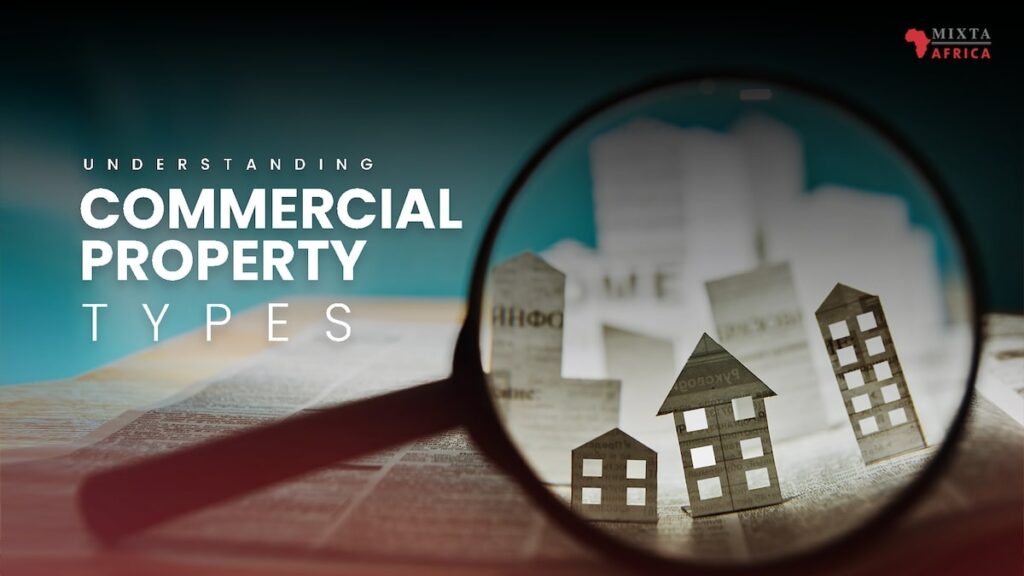Have you ever wandered through a bustling city center or a busy industrial park and wondered, “What exactly goes on in these buildings?”
If so, you’re not alone. These spaces, known as commercial properties, are an integral part of our urban landscapes and economies. But what exactly do we mean when we talk about commercial property types?
Commercial property, in simple terms, refers to any property that is used for business activities. This can range from a towering skyscraper hosting corporate offices to a small café where you enjoy your weekend brunch, or a sprawling industrial park manufacturing everything from textiles to tech gadgets.
So, why is understanding these commercial property types so crucial? Well, if you’re a real estate investor, a business owner, a developer, or even someone with a casual interest in real estate, having a solid grasp of commercial property types can be immensely valuable.
It can help you identify investment opportunities, understand market trends, determine the best use of a property, and evaluate potential risks and returns.
Office Buildings
Office buildings are properties designed to provide workspace for businesses and organizations. They vary in design, location, and size, and are typically characterized by multiple floors of open or segmented office spaces, communal areas, meeting rooms, and other facilities such as pantries or restrooms.
Office buildings can be broadly categorized into three types: high-rise, low-rise, and suburban office buildings.
High-Rise Office Buildings: These skyscrapers, typically located in bustling city centers, are like vertical cities within themselves. They house multiple businesses and organizations over several floors and often come with a premium address.
Low-Rise Office Buildings: These buildings, usually no more than a few stories high, can be found both within the city and on its fringes. They may not have the glamour of a high-rise, but they offer their own benefits, like a homier feel and potentially lower rent.
Suburban Office Buildings: As the name suggests, these are located in suburban areas. They’re typically part of a larger office park that includes multiple buildings and sometimes, shared amenities like a cafeteria or fitness center.
Owning or leasing an office building comes with its own set of pros and cons. Let’s weigh them out, shall we?
Pros of Owning or Leasing an Office Building:
- Financial Upside: If you own an office building and manage to lease out the spaces efficiently, it can generate a steady stream of income.
- Control: Owning an office building gives you control over the property, meaning you can customize and manage it as per your needs.
- Business Presence: Having a dedicated office space can enhance the professional image of your business.
Cons of Owning or Leasing an Office Building:
- Maintenance: Owning an office building means you’re responsible for maintenance, which can be time-consuming and costly.
- Financial Risk: Whether you’re an owner or a lessee, office spaces require a substantial financial commitment. For businesses, especially startups, this can represent a significant risk.
- Dependence on the Market: Office spaces, like any real estate, are subject to market fluctuations. If the market declines or the area becomes less popular, you might struggle to find tenants or face reduced rental income.
Retail Spaces
Retail spaces are commercial properties specifically designed for selling goods or services directly to consumers. Characterized by their accessibility and highly visible locations, these properties serve as the stage for the most direct interaction between businesses and customers. Whether it’s a charming boutique, a bustling supermarket, or a sprawling shopping mall, if there’s buying and selling involved, it’s happening in a retail space.
So, what are the different types of retail spaces? Here’s a quick rundown:
Shopping Centers: These are typically a collection of several independent retail stores functioning together as a unit. They come in various sizes and formats, from the local strip mall hosting a handful of shops to the vast regional shopping center with hundreds of retail outlets.
Standalone Buildings: Often referred to as “out parcel” or “pad site” locations, these are independent retail buildings that are not connected to any shopping center or mall. These spaces often house businesses like restaurants, banks, or other ‘single-tenant’ retailers.
Mixed-use Buildings: These properties combine retail spaces with other types of commercial or even residential spaces. For example, a building might have shops on the ground floor, offices on the next few floors, and residential apartments above.
Malls: These are large, enclosed shopping centers with multiple retail stores, usually anchored by one or more department stores.
Like any commercial property, owning or leasing retail spaces has its pros and cons:
Pros of Owning or Leasing a Retail Space:
- Customer Access: Retail spaces, especially those in prime locations, offer direct access to customers.
- Visibility: A physical retail space can significantly enhance a business’s visibility and branding.
- Investment Potential: For owners, well-located retail properties can be an excellent investment, yielding significant rental income and potential appreciation.
Cons of Owning or Leasing a Retail Space:
- Cost: Prime retail locations can be expensive to buy or lease.
- Maintenance: As with any property, retail spaces require ongoing maintenance and repairs, which can be costly for owners.
- Market Risk: Retail properties are highly sensitive to economic cycles. In a downturn, retailers may struggle, leading to vacancies and reduced rental income for property owners.
Industrial Spaces
These are properties designed for the production, storage, and distribution of goods. From the towering steel structures of factories to the sprawling complexes of warehouses, these unsung heroes of commerce are critical cogs in the wheel of our economy.
Industrial spaces are typically characterized by their large sizes, located outside the main city centers, often near major transportation hubs. They are usually designed for functionality over aesthetics, with features like high ceilings, large doors for loading, and vast open spaces for storage or production.
There are several types of industrial spaces, including:
Warehouses: These buildings are used for storing goods. They play a key role in the logistics and distribution network for many businesses, especially e-commerce giants.
Manufacturing Plants: These are where goods are produced or assembled. They can range from small workshops to enormous factories producing everything from electronics to automobiles.
Flex Industrial Spaces: These properties combine warehouse or industrial space with office space. They offer a versatile solution for businesses that need both types of properties.
Data Centers: While not ‘industrial’ in the traditional sense, these buildings are designed to house servers and other IT equipment. They are a growing segment of the industrial property sector, driven by the rise of digital data and cloud services.
Owning or leasing an industrial space brings its own set of advantages and challenges. Here are some to consider:
Pros of Owning or Leasing an Industrial Space:
- Revenue Potential: For owners, leasing industrial spaces can yield a steady revenue stream, while businesses can optimize their operations with a well-located industrial property.
- Less Competition: Industrial real estate is often less competitive than residential or office real estate, which can lead to better deals.
- Versatility: Many industrial properties, especially flex spaces, offer versatility to accommodate a range of business needs.
Cons of Owning or Leasing an Industrial Space:
- Location Limitations: Industrial properties are often located outside city centers, which may pose commuting challenges for staff.
- Maintenance and Upkeep: Large, complex industrial spaces can require significant maintenance and repairs.
- Initial Investment: Whether buying or leasing, industrial spaces often involve a sizable initial investment due to their large sizes.
Warehouses
These are large commercial properties specifically designed for the storage and handling of goods. Usually located near transport links such as highways, airports, or seaports, warehouses are the essential hubs in the supply chain that keep our goods moving efficiently.
The primary characteristic of warehouses is their vast, open spaces, usually with high ceilings for stacking goods. They’re equipped with loading docks for trucks and often have robust infrastructure for handling and moving goods, including forklifts, conveyor belts, and pallets.
Different types of warehouses cater to various needs:
Distribution Centers: These warehouses act as the intermediary between the supplier and the retailer or customer. They’re designed for quick turnover of goods rather than long-term storage.
Cold Storage Warehouses: These are specially designed for goods that need to be kept at specific temperatures, such as food, medical supplies, or certain chemicals.
Fulfillment Centers: These warehouses handle the packing and shipping of orders for businesses, especially e-commerce companies.
Bulk Warehouses: These are huge structures, often with hundreds of thousands of square feet, designed to store large amounts of a single type of product.
Like any other real estate property, owning or leasing a warehouse comes with its own set of pros and cons:
Pros of Owning or Leasing a Warehouse:
- Revenue and Business Growth: For owners, a well-leased warehouse can offer a steady stream of rental income. For businesses, a strategically located warehouse can boost logistics efficiency and facilitate growth.
- Space and Storage: Warehouses offer ample space for storage, which can be a boon for businesses with large inventories.
- Location: Warehouses are often conveniently located near major transportation links, enhancing logistical efficiency.
Cons of Owning or Leasing a Warehouse:
- Maintenance: Large warehouses can require significant maintenance and security measures, which can be time-consuming and costly for owners.
- Variable Costs: For businesses leasing a warehouse, costs can be variable, with additional charges for utilities, security, or modifications.
- Long-Term Commitment: Leasing a warehouse often involves long-term agreements, which may not offer much flexibility for businesses if their needs change.
Mixed-Use Properties
Ever marveled at a building that houses a bustling café, a couple of thriving offices, and a few residential apartments, all under one roof? These are mixed-use properties, a fascinating blend of residential, commercial, cultural, institutional, or industrial uses within a single property. They embody the ethos of modern urban development, promoting efficiency, convenience, and a sense of community.
Mixed-use properties are characterized by their versatility. They combine different property types, such as residential, retail, office, and sometimes even industrial spaces, in one building or complex. This symbiotic relationship can create a vibrant, self-sustaining microcosm that benefits residents, businesses, and property owners alike.
There are various types of mixed-use properties, including:
Live/Work Spaces: These properties offer residential and workspaces within the same unit, perfect for artists, entrepreneurs, or professionals who work from home.
Retail/Office Spaces: These buildings typically feature retail shops on the ground floor, with offices above. This setup brings customers to the doorstep of the businesses upstairs, while the offices ensure a steady stream of potential customers for the retail stores.
Retail/Residential Buildings: In these properties, residential apartments or condos sit atop ground-level retail spaces. The residents benefit from easy access to shopping, while the shops enjoy a built-in customer base.
Let’s dive into the pros and cons of owning or leasing a mixed-use property:
Pros of Owning or Leasing a Mixed-Use Property:
- Diversification: For owners, mixed-use properties offer a diversified income stream. If one type of tenant (like retail) is struggling, income from other tenants (like residential or office) can help offset losses.
- Convenience: For businesses and residents, mixed-use properties provide convenience and efficiency, as various facilities or amenities are available within the same premises.
- Community Engagement: Mixed-use properties often foster a sense of community, making them attractive to many tenants.
Cons of Owning or Leasing a Mixed-Use Property:
- Complex Management: Mixed-use properties can be more complex to manage than single-use properties due to the differing needs of various tenants.
- Potential Conflicts: Conflicts can arise between different types of tenants, such as noise complaints from residential tenants about retail or commercial activities.
- Zoning and Financing Challenges: Mixed-use properties can face challenges related to zoning laws or financing, as they don’t fit neatly into traditional real estate categories.
Factors to Consider When Choosing a Commercial Property Type
Whether you’re an investor scouting for a lucrative opportunity or a business owner looking for a perfect space, these guidelines can steer your decision-making process.
Location
The old real estate adage holds true for commercial properties as much as for residential ones. The location of your property can significantly influence its value and suitability. A retail store thrives in high-traffic areas, while an office building benefits from proximity to public transportation. For industrial properties or warehouses, accessibility to major transportation routes is vital. Before settling on a location, consider factors like the local economy, demographics, competition, and future growth projections.
Budget
Understanding your financial constraints is crucial when choosing a commercial property. Purchasing or leasing costs, maintenance expenses, taxes, and potential renovation or fit-out costs all factor into the total expense of owning or leasing a property. You also need to consider the potential return on investment if you plan to lease the space.
Zoning Regulations
Zoning laws govern what activities can take place on a property. For example, certain areas might be zoned for residential use only, prohibiting commercial activities. Always check the local zoning regulations to ensure your intended use of the property is permitted. Working with a knowledgeable real estate agent or lawyer can help navigate these complex regulations.
Size and Layout
The size and layout of the commercial property should align with your operational needs. If you’re a retailer, you need enough space for your products, customers, and potential storage. For office buildings, consider the working space requirements per employee, common areas, meeting rooms, and facilities. For industrial or warehouse properties, consider the space needed for equipment, storage, and operations.
Amenities
The presence of certain amenities can make commercial property more attractive to potential tenants. For office spaces, this might mean a well-equipped pantry, break rooms, or nearby dining options. For retail spaces, ample parking and accessibility features may be crucial. For industrial spaces, specific technical amenities like high-capacity electricity supply, loading docks, or specialized storage facilities could be essential.
Financing Options for Commercial Property Types
Venturing into the realm of commercial real estate requires substantial financial planning. Whether you’re a seasoned investor or a business owner branching into property ownership, understanding your financing options can be the key to unlocking the potential of your next commercial property purchase.
Commercial Mortgages
Similar to residential mortgages, commercial mortgages are loans secured by the commercial property you wish to purchase. The loan term typically ranges from 5 to 20 years, and the property itself serves as collateral for the loan. Most commercial mortgages have a fixed interest rate, providing predictability for the borrower.
Obtaining a commercial mortgage usually requires a solid credit history, a viable business plan (if the property is to be used for your own business), and a significant down payment, typically around 20-30% of the property’s value. This route can be a great choice for those with a solid business track record and the financial capacity to meet the sizeable upfront costs.
Mezzanine Financing
For those seeking additional funding beyond what a primary mortgage can provide, mezzanine financing may be a viable option. This form of financing combines elements of debt and equity financing, effectively filling the gap between the primary mortgage and the total purchase price of the property.
In a mezzanine loan, the borrower pledges equity interest in the company that owns the property as collateral, rather than the property itself. If the borrower defaults, the lender can claim ownership of the company and, therefore, the property. While mezzanine financing can provide significant capital, it typically comes with higher interest rates and is often considered riskier than other financing options.
Bridge Loans
Bridge loans are short-term loans designed to provide immediate funding. They’re often used to finance a property while longer-term financing is secured or while the property is improved or sold. These loans “bridge” the gap during periods when financing is needed but not yet available.
Bridge loans can be valuable tools for those needing to act quickly on a commercial property purchase, such as in a competitive market or auction scenario.
They’re also beneficial for property developers or flippers who plan to improve and quickly sell a property. However, bridge loans usually have higher interest rates than long-term financing options and are best viewed as a short-term solution.
Tips for Buying and Selling Commercial Property Types
Here are some key tips for buying and selling commercial properties:
Understanding the Local Market
Knowledge is power in real estate transactions. Thoroughly understanding the local market, including the average price per square foot, vacancy rates, popular property types, and emerging trends, can give you a competitive edge.
For buyers, this knowledge can guide your property search and pricing strategy. For sellers, it can help you price your property attractively and understand what potential buyers are looking for.
Identifying Potential Tenants or Buyers
For buyers, identifying potential tenants before purchasing a property can be beneficial. If you already have a tenant lined up, you can tailor your property search to their needs.
For sellers, knowing who your likely buyers are can help you market the property effectively. For example, if you’re selling a warehouse, potential buyers might include logistics companies, large retailers, or real estate investment trusts (REITs).
Negotiating the Price and Terms of the Sale
Negotiation is a critical aspect of any real estate transaction. Having a thorough understanding of the property’s value, the local market conditions, and your own financial situation can strengthen your negotiating position.
Don’t be afraid to negotiate terms beyond the price, such as the closing timeline, contingencies, or inclusions (like fixtures or furniture). Engaging a knowledgeable commercial real estate agent can be very helpful at this stage.
Preparing the Property for Sale or Lease
First impressions matter in real estate. If you’re selling, ensure the property is clean, well-maintained, and free of clutter. Consider investing in professional photography and a well-designed listing brochure to highlight the property’s best features.
If you’re buying a property with the intention to lease it, consider how you might enhance the property to attract quality tenants. This could involve cosmetic improvements, adding amenities, or adjusting the layout to suit potential tenants.
Commercial Property Management
Here, we explore the key aspects of managing commercial properties: tenant screening and selection, lease agreements and renewals, maintenance and repairs, and rent collection and accounting.
Tenant Screening and Selection
Finding the right tenant for your commercial property is crucial. This involves advertising the property, hosting viewings, and carefully screening interested parties.
A rigorous screening process often includes verifying the prospective tenant’s business financials, checking references, and meeting them in person. Finding a tenant who is a good fit for your property can minimize vacancies and potential issues down the line.
Lease Agreements and Renewals
The lease agreement is a legal contract between you and the tenant. It sets out the terms of the lease, including the rent amount, lease duration, responsibilities of each party, and any other conditions or rules. It’s essential to clearly articulate all terms and conditions to avoid any misunderstanding or legal issues later. Regularly reviewing and renewing leases can ensure your rental income keeps pace with the market.
Maintenance and Repairs
Regular maintenance and prompt repairs can keep your commercial property in good shape, prevent minor issues from escalating into major problems, and keep tenants satisfied. This involves routine inspections and servicing, attending to any issues reported by tenants, and planning for long-term maintenance, such as roof replacement or repainting.
Rent Collection and Accounting
Collecting rent promptly, tracking income and expenses, and maintaining accurate financial records are all integral parts of property management. Modern software can streamline these tasks, automating rent collection, tracking expenses, and generating financial reports. Efficient financial management can help you monitor your property’s performance, plan for future expenses, and ensure your taxes are in order.
Conclusion
To successfully navigate the world of commercial real estate, it’s essential to stay up-to-date with industry trends. Changes in the economy, shifting consumer behavior, technological advancements, and new legislation can all impact the value and desirability of commercial property types. Keeping a finger on the pulse of these changes allows you to adapt your strategy, make informed decisions, and stay ahead of the competition.
Investing in and managing commercial real estate can be a profitable venture, but it also comes with its challenges. Whether you’re purchasing your first commercial property or expanding your portfolio, it’s crucial to arm yourself with knowledge, plan carefully, and seek professional advice when necessary.












